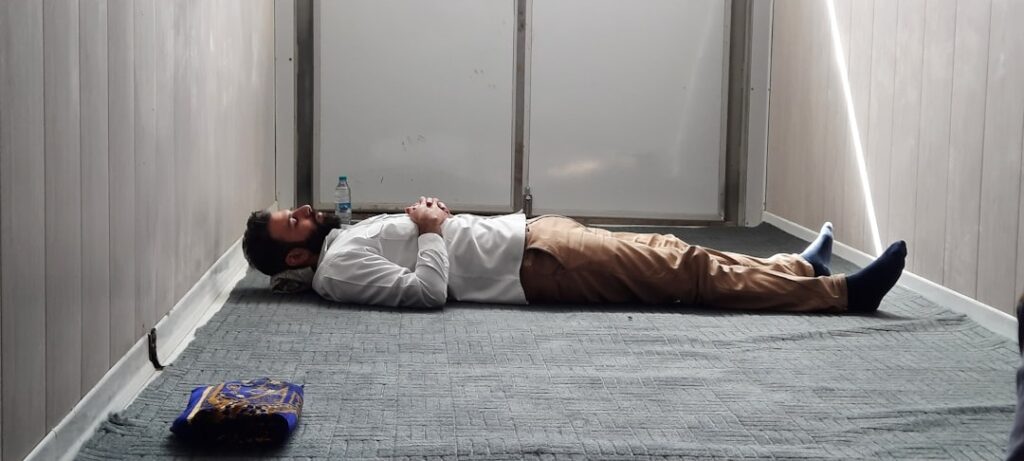
by Aziz Ansari (https://unsplash.com/@blindmoon2020)
Cognitive Behavioral Therapy for Insomnia (CBT-I) is a structured program that helps individuals address thoughts and behaviors that cause or worsen sleep problems. Unlike medication, CBT-I tackles the root causes of insomnia, providing sustainable and effective results. By focusing on the psychological and behavioral aspects of sleep disturbances, CBT-I offers a holistic approach that can lead to lasting changes in sleep patterns. The therapy empowers individuals to take control of their sleep health, fostering an understanding of sleep mechanisms and the development of healthier sleep habits.
What is CBT-I?
CBT-I is a form of therapy specifically designed to treat insomnia. It focuses on identifying and changing thoughts and behaviors that negatively affect sleep. By addressing misconceptions and maladaptive behaviors related to sleep, CBT-I aims to break the cycle of insomnia. The therapy involves a combination of cognitive interventions and behavioral strategies aimed at improving sleep habits and establishing a healthier sleep routine. Through CBT-I, individuals learn to modify their lifestyle and environment to support better sleep, ultimately reducing reliance on medications.
How CBT-I Works
CBT-I is usually conducted over several weeks and involves multiple components that collectively address various aspects of sleep health:
- Sleep Education: Understanding the science of sleep, including sleep cycles and factors affecting sleep, is a crucial first step. Educating individuals about the natural variations in sleep needs and patterns can help set realistic expectations and reduce anxiety about sleep.
- Cognitive Restructuring: This involves identifying negative thoughts and beliefs about sleep and replacing them with positive ones. Restructuring thoughts can alleviate the pressure to “perform” during sleep, reducing anxiety and promoting a more relaxed bedtime mindset.
- Stimulus Control: This technique involves creating a strong association between the bed and sleep by limiting activities in the bed to only sleep and intimacy. By reinforcing the bed as a cue for sleep, stimulus control helps retrain the brain to associate the bedroom environment with relaxation and rest.
- Sleep Restriction: Initially limiting the time spent in bed to match the actual sleep time to increase sleep efficiency. Over time, this approach helps consolidate sleep into a more restorative period and can gradually increase total sleep time as sleep efficiency improves.
- Relaxation Techniques: Incorporating methods like deep breathing, meditation, or progressive muscle relaxation to reduce stress and promote sleep. These techniques help calm the mind and body, making it easier to fall asleep and stay asleep.
- Sleep Hygiene: Adopting habits that promote consistent, uninterrupted sleep. Good sleep hygiene includes creating a sleep-conducive environment and establishing a calming pre-sleep routine to signal the body that it’s time to wind down.
The Benefits of CBT for Sleep Disorders

by Annie Spratt (https://unsplash.com/@anniespratt)
CBT-I is considered one of the most effective behavioral sleep interventions available. It addresses insomnia at its core, offering a comprehensive treatment that can be more effective than medication alone in the long run. Here are some key benefits:
Long-Term Improvement
Unlike medication, which often only provides temporary relief, CBT-I offers long-term solutions by addressing the underlying causes of sleep disorders. It fosters lasting change by equipping individuals with the skills to manage their sleep patterns proactively. Many patients experience lasting improvements in their sleep quality. This long-term improvement is not just about better sleep but also about improved daily functioning and quality of life.
No Side Effects
CBT-I is a non-invasive, drug-free treatment. This makes it a safer option for those who wish to avoid the potential side effects associated with sleep medications. Without the risk of physical dependencies or adverse reactions, individuals can focus on sustainable sleep improvement strategies. The absence of side effects makes CBT-I an appealing choice for people of all ages, including those with preexisting health conditions that might be exacerbated by medication.
Personalized Treatment
CBT-I can be tailored to meet the specific needs of each individual. Therapists work with patients to identify their unique sleep challenges and develop a customized treatment plan. This personalization ensures that therapy addresses specific issues and adapts to the individual’s progress over time. By focusing on personal goals and obstacles, CBT-I enhances the likelihood of success and makes the therapy more engaging and relevant.
Empowering Patients
CBT-I empowers individuals by giving them the tools and knowledge needed to manage their sleep issues independently. Patients learn to identify and modify behaviors that negatively affect their sleep. This empowerment extends beyond the therapy sessions, as individuals gain confidence in their ability to improve their sleep quality without external aids. The skills acquired through CBT-I can be applied to other areas of life, promoting overall mental and emotional resilience.
Techniques Used in CBT for Sleep
Cognitive Techniques
Cognitive techniques in CBT-I focus on changing harmful beliefs and attitudes about sleep. Therapists work with patients to challenge unrealistic expectations and reduce anxiety related to sleep. For example, if a patient believes they “must” get eight hours of sleep to function the next day, a therapist might help them reframe this thought to reduce pressure and anxiety. By addressing these cognitive distortions, individuals can reduce the stress that often exacerbates insomnia, paving the way for a more relaxed approach to sleep.
Behavioral Techniques
Behavioral techniques are critical in establishing healthy sleep patterns. These strategies focus on modifying actions and environmental factors to facilitate better sleep:
- Sleep Scheduling: Setting a consistent bedtime and wake-up time to regulate the body’s internal clock. This regularity helps stabilize circadian rhythms and promotes more predictable sleep cycles.
- Creating a Sleep-Friendly Environment: Making changes to the bedroom to promote sleep, such as reducing noise, blocking out light, and keeping the room cool. A comfortable and inviting sleep environment supports relaxation and reduces disturbances that can interrupt sleep.
- Avoiding Stimulants: Limiting caffeine, nicotine, and other stimulants, especially in the afternoon and evening. By minimizing these substances, individuals can prevent disruptions to their sleep cycle and improve sleep quality.
Relaxation Techniques
Relaxation techniques help calm the mind and prepare the body for sleep. These might include:
- Deep Breathing: Focusing on slow, deep breaths to relax the body. This simple practice can significantly reduce tension and anxiety, creating a sense of calm conducive to sleep.
- Progressive Muscle Relaxation: Tensing and then relaxing each muscle group to release tension. This method helps increase body awareness and reduces physical stress, making it easier to fall asleep.
- Guided Imagery: Visualizing a calming scene to distract from racing thoughts. By mentally transporting oneself to a peaceful setting, individuals can escape stressors and ease into sleep more readily.
Who Can Benefit from CBT-I?

by Ortopediatri Çocuk Ortopedi Akademisi (https://unsplash.com/@ortopediatri)
CBT-I is suitable for most individuals struggling with sleep disorders, including:
- People with chronic insomnia: Those who have persistent trouble falling or staying asleep can benefit greatly from the structured approach of CBT-I.
- Those experiencing stress-related sleep problems: People whose sleep issues stem from stress or anxiety may find relief through CBT-I’s cognitive and relaxation techniques.
- Individuals looking to reduce or eliminate sleep medication: For those dependent on sleeping pills, CBT-I offers a path to regain natural sleep patterns without pharmaceutical aid.
- Patients with coexisting conditions, such as anxiety or depression, that affect sleep: CBT-I can be particularly beneficial for those whose mental health issues exacerbate their sleep problems, providing tools to manage both simultaneously.
Success Stories
Many patients have successfully used CBT-I to overcome sleep disorders. For example, John, a 45-year-old teacher, struggled with insomnia for years. After completing a CBT-I program, he reported significant improvements in his sleep quality and overall well-being. His story is just one of many that highlight the effectiveness of CBT-I. Success stories like John’s demonstrate the transformative potential of CBT-I, offering hope and motivation to others facing similar challenges.
Getting Started with CBT-I
If you’re considering CBT-I, the first step is to consult with a healthcare provider or sleep specialist. They can assess your sleep problems and recommend an appropriate treatment plan. Many therapists are trained in CBT-I, and there are also online programs and resources available for those who prefer a self-guided approach. Engaging with a professional ensures that the therapy is tailored to your specific needs and that progress is monitored effectively.
Finding a Therapist
When looking for a therapist, it’s important to choose someone with experience in CBT-I. You can search for qualified professionals through directories provided by organizations like the American Academy of Sleep Medicine or the Association for Behavioral and Cognitive Therapies. A qualified therapist can provide the guidance and support necessary for successful treatment, helping to navigate challenges and track improvements throughout the therapy process.
Online Resources
For those who prefer an online approach, several digital platforms offer CBT-I programs. These can be a convenient and cost-effective way to access therapy from the comfort of your home. Online programs often include interactive elements, such as virtual consultations and progress tracking, which can enhance the therapeutic experience. They offer flexibility and accessibility, making CBT-I available to a broader audience regardless of geographic location or time constraints.
Conclusion
Cognitive Behavioral Therapy for Insomnia is a powerful tool for improving sleep quality without the need for medication. By addressing the root causes of sleep disorders and empowering individuals with practical strategies, CBT-I offers a sustainable solution for better sleep. Whether you struggle with chronic insomnia or occasional sleep disturbances, CBT-I can help you achieve the restful nights you deserve. Embracing CBT-I can lead to not only improved sleep but also enhanced overall health and well-being, enriching every aspect of life.

